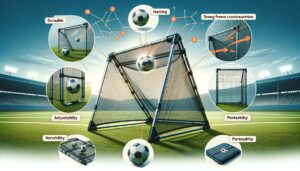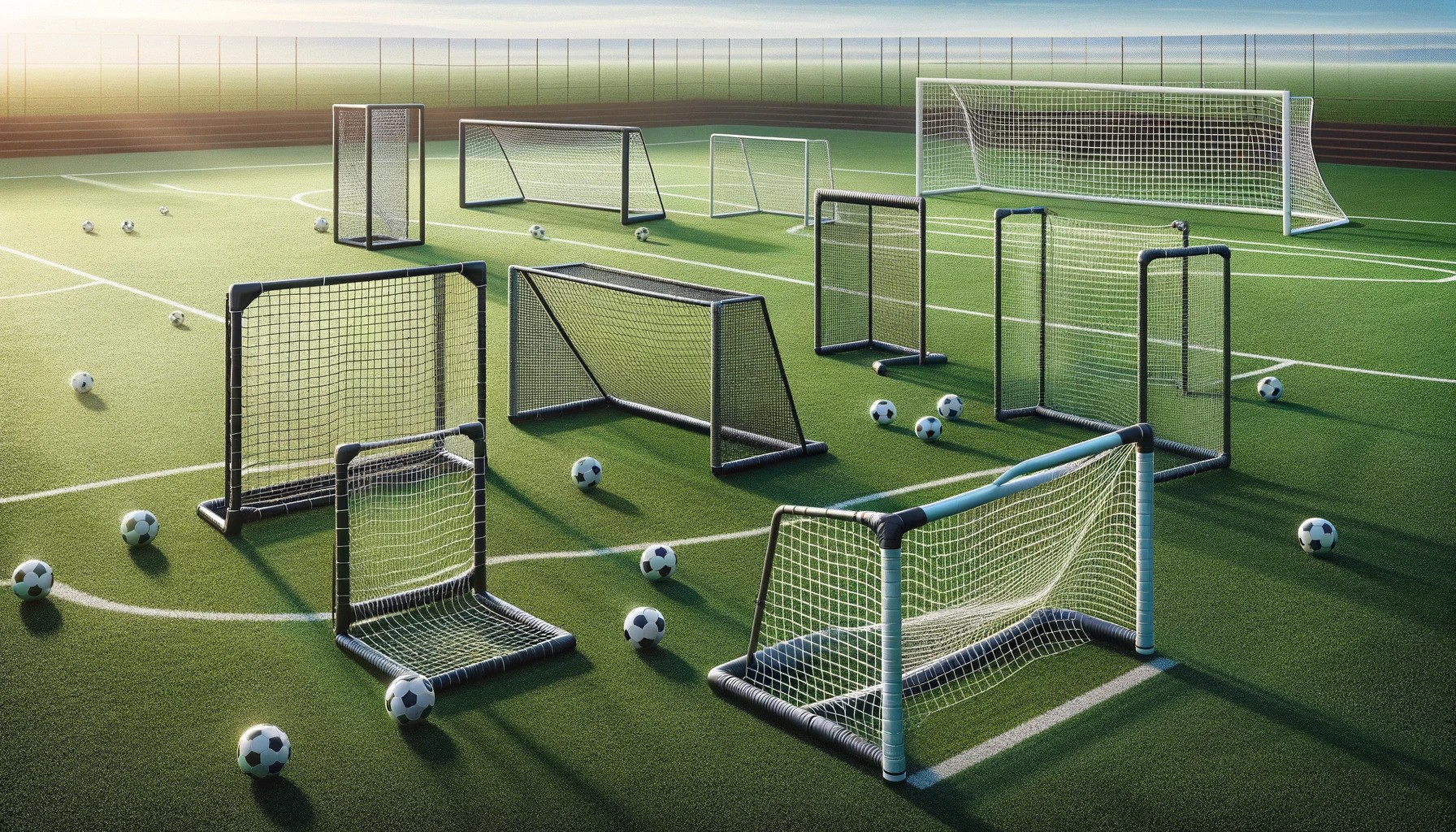When it comes to elevating your soccer skills to the next level, choosing the perfect rebounder plays a pivotal role. Picture yourself in your backyard or at the local park, where every kick against a rebounder translates into a significant leap in your game. As someone who has personally experienced the transformative effect of these trainers, I can attest to their usefulness and impact.
Rebounders come in various setups, from simple netting stretched over a metal frame to more sophisticated options with adjustable angles. The quality of the mesh and frame, crucial factors in durability, should never be overlooked. For players of all ages and levels, from individuals practicing in their own space to teams in training, the right rebounder is an indispensable tool.
List of 5 Best Soccer Rebounders
- Kwik Goal Rebounder
- PRO Skill Rebounder
- Kwik Goal AFR-1 Rebounder
- VIVO Ultra Dual Rebounder
- Kwik Goal AFR-2 Rebounder
What are soccer rebounders used for?
Soccer rebounders are essential tools for players looking to develop their skills and sharpen their game. Whether it’s for a younger player in a local club or a professional in the Premier League or MLS, these rebounders play a crucial role. They are particularly useful in honing technical elements such as passing, receiving, and maintaining a good touch with the ball. As someone who has used these devices in both training sessions and team drills, I can vouch for their effectiveness in improving game prowess.
Enhancing Reaction Time and Tactical Understanding
From a group practice perspective, rebounders are excellent for enhancing reaction time and tactical understanding. This is particularly true for attackers and midfielders who need to react swiftly in matches. The ability to receive a ball and make quick decisions is paramount in soccer, and rebounders provide a controlled environment to perfect these skills. They are equally beneficial for older and more skilled players who seek to maintain and refine their abilities at a higher level.
Rebounders are not just about improving individual technical skills; they also supplement a player’s overall understanding and adaptability in the game. For instance, in my personal experience, integrating rebounders into practice routines has led to noticeable improvements in both individual and team performance. They encourage players to think faster and adapt to changing game situations, essential qualities for excelling in soccer at any level.
Are soccer rebounders good?
As someone deeply immersed in the world of soccer, both as a player and a coach, I can confidently affirm that soccer rebounders are not just good; they are great for players of all ages and levels. These tools are incredibly ideal for improving ball handling and passing accuracy, crucial components in a player’s skill arsenal. Whether you are a beginner looking to master the basics or a seasoned player aiming to refine your craft, a rebounder offers a consistent and reliable way to practice.
Versatility and Adaptability for Solo and Team Training
The versatility of soccer rebounders is worth highlighting. They are suitable for alone practices or with a friend or team. Their portable nature means they can be used anywhere, from your backyard to the local park. I’ve personally witnessed how rebounders can transform a mundane solo session into an interactive and dynamic practice, helping players develop a better sense of timing and control.
Furthermore, the variety in sizes makes these rebounders perfect for different training needs. For younger players, smaller rebounders make ball mastery easier, while larger ones offer a more challenging scenario for advanced players. In my experience, using a rebounder in regular practices with buddies or team members significantly enhances the overall training experience, providing a fun and effective way to enhance skills.
What should I look for in a soccer rebounder?

When you’re shopping for a soccer rebounder, it’s essential to consider not just the price or brand but the features that make it the ideal fit for your needs. As both a coach and a long-time soccer enthusiast, I’ve found certain aspects crucial for a top-shelf rebounder.
Size and Weight
The size and weight of a soccer rebounder are crucial, especially for those who need to frequently transport it. For coaches moving gear to a field or parents setting up in the backyard, a lightweight, portable rebounder is invaluable. Yet, durability shouldn’t be compromised. A sturdy, solid frame, be it metal for professionals or fiberglass and plastic for younger players, is essential for balancing portability and sturdiness.
Assembly and Disassembly
Quick and easy-to-assemble rebounders save valuable time. It’s beneficial to have a rebounder that can be easily set up and taken down, making it convenient for both practice and storage.
Framing and Material
The framing and material of the rebounder impact both its durability and weight. A durable, adjustable frame can withstand heavy usage and wear and tear. The choice between metal, fiberglass, or plastic frames will affect the rebounder’s weight and hence its portability.
Considering the Player’s Needs
Different players and coaches have varying requirements. Goalies may prefer a design that enhances their blocking, punching, and diving saves, while strikers might look for features that improve their kicking strength. Parents should seek rebounders that can grow with their children, offering long-term usage.
Training Features
Select a rebounder that offers varied training exercises to develop a well-rounded game. A top-shelf rebounder should enable you to sharpen various skills, from ground passing to aerial techniques. It’s not just about the rebound; it’s about the versatility in practice scenarios it offers.
Quality and Realism
The overall quality of the rebounder affects how realistic the training experience is. The thickness of the roping and the sturdiness of the frame contribute to a more game-like feel, aiding in better preparation for actual game scenarios.
Conclusion
In wrapping up, the quest for the “Best Soccer Rebounders” boils down to finding a perfect blend of practicality and performance. Whether you’re a budding young player, a seasoned professional, or a dedicated coach, the right rebounder can significantly enhance your training experience.
By prioritizing aspects like durability, ease of use, adaptability to different training needs, and the ability to simulate real-game scenarios, you can select a soccer rebounder that not only meets your immediate needs but also grows with your evolving skills. Remember, the best rebounder is one that complements your passion for the game, pushing you towards greater heights in your soccer journey.
FAQs: Best Soccer Rebounders
Are football rebounders worth it?
Yes, football rebounders are definitely worth it. They are a versatile tool that enhances skills like ball control, passing, and accuracy. They’re great for individual or team training, suitable for all ages and skill levels.
How do you use a soccer rebounder?
To use a soccer rebounder, position it at a suitable angle and distance. Kick the ball towards it, and practice receiving the return. It’s ideal for improving passing, shooting, and controlling the ball with various parts of your body.
How to make a soccer rebounder?
Making a soccer rebounder involves constructing a frame, typically from metal or PVC pipes, and attaching a tightly stretched, durable net or bungee cords. Ensure it’s sturdy and the size is appropriate for your training needs.
What is the disadvantage of rebounding?
The main disadvantage of rebounding is the lack of variability compared to a real game scenario. It can’t perfectly replicate the unpredictability of a ball coming from different directions or speeds.
How do I choose a good rebounder?
Choose a good rebounder based on its size, portability, durability, and the quality of materials used. Consider your personal training goals, the space you have available, and whether you’ll use it for individual or team practices.
Is rebounding good or bad?
Rebounding is generally good as it helps in developing soccer skills, improving reaction time, and providing consistent practice. However, it should be complemented with other training forms to cover all aspects of the game.
Who should not do rebounding?
Rebounding is not recommended for individuals who might be prone to injury from repetitive, high-intensity ball kicks, especially without proper warm-up. It’s always advisable to consult a coach or a fitness professional if you have any concerns.

